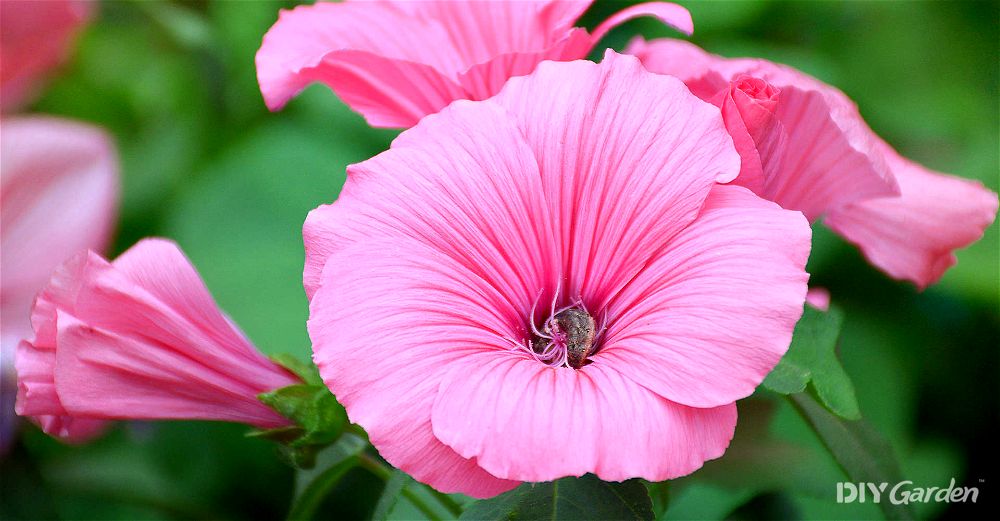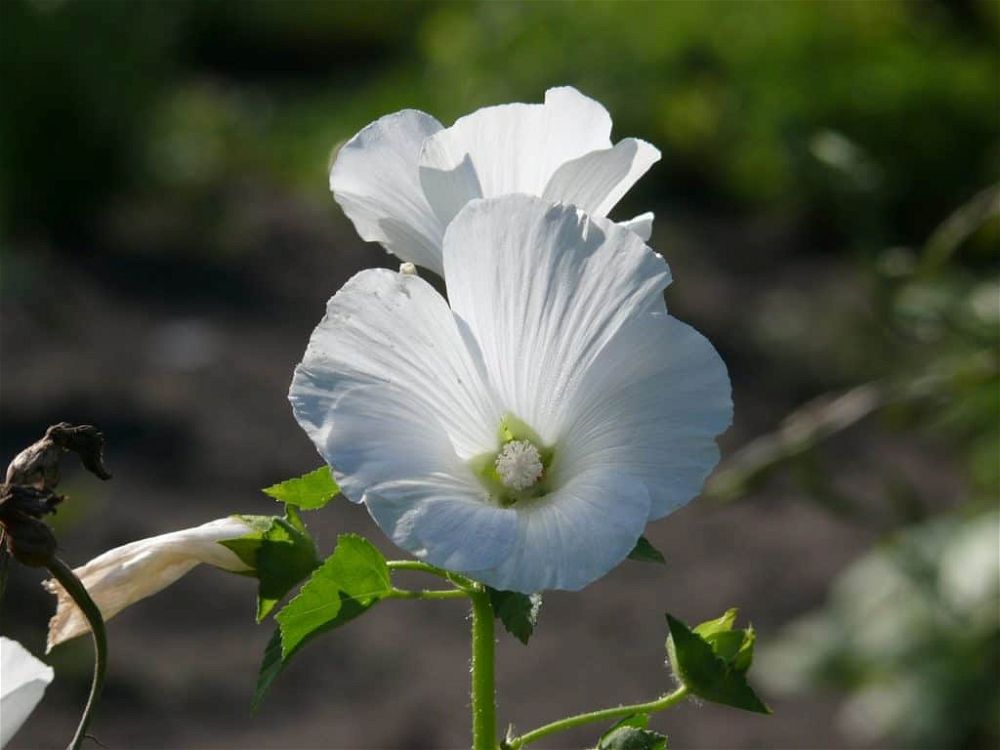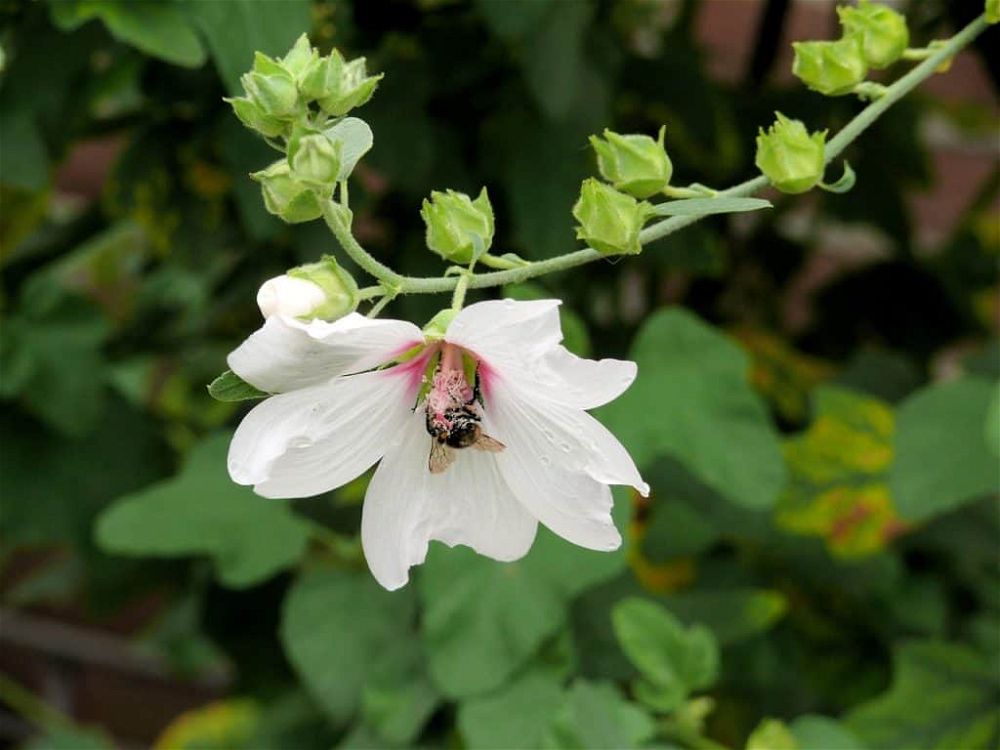
Jump to a Section
Plant Overview
| Common Name | Garden Mallow, Rose Mallow, Tree mallow |
|---|---|
| Scientific Name | Lavatera |
| Plant Family | Malvaceae |
| Origin | The Mediterranean |
| Height | Depends on variety but perennials have a maximum height of 8 feet (2.5 metres) |
| Light | Full sunlight to part shade |
| Temperature | -40 — +30 °C |
| Hardiness | Perennial varieties are hardy; however, annuals will die after the first frosts of winter |
| Soil | Will tolerate most soils, even poor ones. It prefers free drainage. Lavatera is tolerant of salt and so is suitable for planting in coastal gardens |
| Fertiliser | A general-purpose fertilizer applied during the growing season will keep your plant flowering well. Avoid over-feeding as this can lead to lush foliage but few flowers |
| Propagation | Lavatera is easily grown from seed. They can also be propagated by means of softwood cuttings |
| Pests | Aphids, Spider mites |
| Difficulty | Very easy |
Lavatera is an easy-to-grow, upright shrubby plant with attractive green foliage. It has large flowers that range in colour from white to deepest rose. It flowers from midsummer until the first frost.
It is mainly pest and disease resistant and will attract beneficial insects such as butterflies and bees. It can cope with poor soil and coastal weather – lavatera is considered pretty hardy.
Some forms of lavatera are annuals while others are perennial. Perennial Lavatera is a large shrub that blooms in summer, whereas annuals bloom from summer to the first frost. Because it is fast growing, and often flowers in its second year, perennial lavatera is a great plant to add maturity and colour to a relaxed planting scheme in a relatively short time. It only lives for around four to five years but reseeds easily.
Read on to find out how to care for this low-maintenance, attractive plant.
Lavatera Care
Lavatera is easy to grow and will tolerate a wide variety of conditions.
A classic plant of the cottage garden, they also do well in coastal sites. Because they grow so quickly, they are a useful plant for filling a gap or making a new garden look established more quickly. They are not long-living plants. However, their fast growth and prolific flowers make them great value for money, especially as they can easily be propagated from seed.
Soil Requirements
Lavatera grows in most well-drained soil, including poor soil. Because they are tolerant of salt, they can also suit a coastal garden.
Light Requirements
Your Lavatera will bloom best if it is planted in full sunlight. However, the plant will tolerate partial shade.
Water Requirements
The plant copes well with dry weather. However, it will benefit from watering in periods of drought. If the soil around it becomes too dry it will begin to drop its blooms.
Fertiliser Requirements
Feed the plant a general-purpose garden fertiliser monthly during the growing season. Do not be tempted to over-fertilise your lavatera or you will end up with abundant leafy growth but few blooms.
Pruning Advice
Lavatera is best pruned in early to mid-spring, once the danger of frost has passed.
It is quite a simple process as these shrubby plants cope well when cut back hard. At this time of year, your plant will have new shoots growing at the base of the plant. These are the flowering shoots for this year. All other wood can be cut back. This will regenerate the plant and prevent the stems from becoming old and woody and failing to flower. Cutting back your lavatera will promote vigorous growth and the development of strong new shoots that should provide you with plenty of summer flowers.
To prune your Lavatera take a clean sharp pair of secateurs and cut all stems back to 1 foot above ground level. Some of the thicker stems may require loppers or a pruning saw.
Now, if there are any weak or brittle stems, these should be removed to ground level as they are probably dead or dying. Most dead stems will snap easily. If you are not sure if a stem is dead, scrape a little of the bark away. If the stem is green under the bark it is alive. If it is brown, it’s dead.
When pruning back healthy growth, look for a swelling on the stem. This is the point where a new shoot is developing. You should make your cut just above this bulge.
Lavatera Propagation
Propagating Lavatera is very easy. In fact, if you already have one of these plants you may find it has self-seeded and you have numerous baby plants in the beds around them. You can propagate Lavatera from seed and softwood cuttings.
Propagating Lavatera From Seed
The plants can easily be grown from seed. It is best to plant them directly in the soil in the place you want them to grow. This is because they have a long root system so do not do well when transplanted. Plant the seeds in spring, after the chance of frost is passed. Space the seeds 18-24 inches (45- 60 cm) apart. They will germinate in around 15 to 20 days.
Seed can also be planted earlier, indoors to get a head start. Sow three to four seeds in a peat pot and thin out all but the strongest seedling. Once the seedling is 4 inches (10 cm) high, harden off and then plant the whole pot in the garden to prevent disturbing the roots.
Propagating Lavatera From Softwood Cuttings
Perennial lavatera can also be propagated from softwood cuttings in spring or summer.
Choose healthy stems that are just beginning to turn woody at the base.
With a clean, sharp knife or secateurs, trim each cutting. Make the lower cut just below a leaf in new wood. Then trim the overall cutting down to 3 -6 inches (7.5cm to 15 cm).
Remove all leaves from the lower half of the cutting and remove flower buds.
Dip the cut base in hormone rooting powder as this speeds up rooting and reduces the chances of rotting.
Prepare a 7.5 cm pot with free draining compost for each cutting. Using a dibber or pencil, make a hole for the cutting. Place the stem in the hole and water lightly. Place a plastic bag over the pot and secure with an elastic band.
Position your cuttings in a sheltered but sunny spot in the garden out of direct sunlight. Keep an eye on the cuttings to ensure they do not dry out. You will know your cuttings have taken when you see new growth coming from the stem, or roots appearing through the holes in the bottom of the pot. This will take 4-8 weeks. You can then pot them on and leave them in a sheltered spot over winter for planting out the following spring.
Common Lavatera Problems
Although Lavatera is rarely bothered by pests and diseases, there are still a few problems you may come up against.
Pests
The following pests are the ones most likely to cause damage to your Lavatera.
Spider Mites
Spider mites, as the name suggests, resemble tiny spiders. You may see their tiny webs before you notice the mites themselves. They will suck the sap from the young stems and leaves of your plant. This can cause the leaves to yellow and become deformed. Luckily, this plant is quite robust so doesn’t suffer too much. Spray the leaves with a jet of water to knock the mites off. You can also use insecticidal soap if the infestation is severe.
Aphids
Aphids are tiny insects that suck the sap of plants. They are unlikely to critically endanger your plant, but they can cause a lack of plant vigour and distorted growth. They also excrete a sticky substance on foliage which also encourages the growth of sooty moulds. They can be treated in the same way as spider mites, with a jet of water for mild cases and insecticidal soap for larger infestations.
Diseases
Lavatera is generally sturdy, strong and disease resistant. However, they do sometimes become affected by hollyhock rust, especially in damp, foggy or misty conditions.
Hollyhock Rust
Hollyhock rust is a fungus that attacks many plants. It is generally not fatal to Lavatera; however, it can cause the foliage to turn yellow and the leaves to wither and drop. You may see yellow spots on the tops of the leaves and raised spore-containing pustules on the undersides. It is usually most virulent in spring and autumn but can continue in summer if the weather is damp.
To prevent hollyhock rust you should keep the area around the plant free from weeds and dead matter. It is also wise to water your plant early in the day to allow the moisture to evaporate from the foliage. You should cut off infected leaves as you find them. Thin out the plant if necessary to allow for better air circulation. You can also use a fungicide in early spring if the problem is extensive.
After the Lavatera finishes flowering, you should prune away all infected leaves and stalks to soil level and destroy them. Luckily this is a vigorous plant that benefits from hard pruning and dies back over winter, so infected growth can be removed without harming the plant.
Mulching you plant will also help to cover any spores on the ground and prevent reinfection. Keep the mulch away from the plant base to avoid rotting the stems.
Lavatera Varieties
There are many varieties of Lavatera and they can be split into annuals and perennials. Annual varieties will be sown and flower the same year, usually dying with the first frost. Perennial types will last for several years and can grow into large shrubs. They benefit from heavy pruning in the spring to promote new growth.
Annual Lavateras
Annual varieties bear a profusion of hollyhock-like blooms. Many of these individual flowers can be three inches wide and come in a range of colours from white to ruby-red and some feature contrasting veining.
L. Trimestris
This is perhaps the most widely grown annual Lavatera. These plants reach a height of around 2 feet (0.5 metres) and come in a range of colours from the pure white ‘Mont Blanc’ to a light pink called ‘Pink Beauty’, the deeper pink of ‘Silver Cup’ and the cherry-hued ‘Ruby Regis’.
These annuals, which typically bloom from July to autumn, make useful fillers when gardens need an extra boost of colour. The spikes also make beautiful cut flowers.
Perennial Lavateras
The perennial varieties are often called tree mallows. They are shrubby plants that grow quickly. Perfect in borders and at the back of flower beds. They add maturity and colour to the garden in a relatively short time, generally flowering profusely in their second year.
Lavatera maritima
Lavatera maritima is a fast-growing shrubby plant that reaches 8 feet (2.5 metres) tall and can spread up to 12 feet (3.5 metres). It produces abundant large pink to white flowers. The leaves and stems have a soft grey-green hue. This species is rugged and especially easy to grow, tolerating most conditions and hardy to at least -8°c. It is a perfect choice for coastal gardens.
L. thuringiaca
L. thuringiaca is the most widely grown perennial lavatera. The flowers range from pale to rich pinks depending on the variety. Though they are shrubby in appearance, these perennials die back to the ground each year in winter. They can reach a height of 6 feet (1.8 metres).
Lavatera x clementii ‘Barnsley’
Lavatera x clementii ‘Barnsley’ is popular cottage garden favourite. It reaches a maximum height and spread of 7 feet (2 metres). It produces hollyhock-like flowers from June until September. These flowers are white with a red centre and change to a pale pink as they mature.
Lavatera ‘Barnsley Baby’
For those with a smaller garden, there is a more compact version of Barnsley available called Barnsley baby. This plant has all the charm of its bigger brother but reaches a maximum height of 75cm (30″).
Lavatera x clementii ‘Rosea’
Lavatera x clementii ‘Rosea’ is a very popular variety due to its abundant pink flowers and soft, felty leaves. It flowers from June to September providing summer-long colour.
FAQs
It sounds like your lavatera is not getting enough sun. These plants can tolerate some shade but will flower best in the sun. The yellowed leaves could also indicate a lack of iron. Try using an iron-rich fertiliser such as blood, fish and bone to see if that perks your plant up.
It sounds like your plant is suffering from the heat. It has plenty of new growth but as it is still young, may not have substantial enough roots to support it. You could try creating some artificial shade with greenhouse netting or fleece and see if this helps your young plant stay sturdy and upright. It will also require plenty of water if the weather is very hot and dry.
It is possible that your Lavatera suffered from wind rock. This can happen when strong winds rock the plant and cause damage to the root system. To prevent this from happening in the future make sure the plant is well firmed in when planting. You may also want to stake plants that are situated in exposed areas. Lavatera often like to be partly sheltered from the worst of the weather so try to ensure it is near a fence, wall or other shrubs or trees.



Share